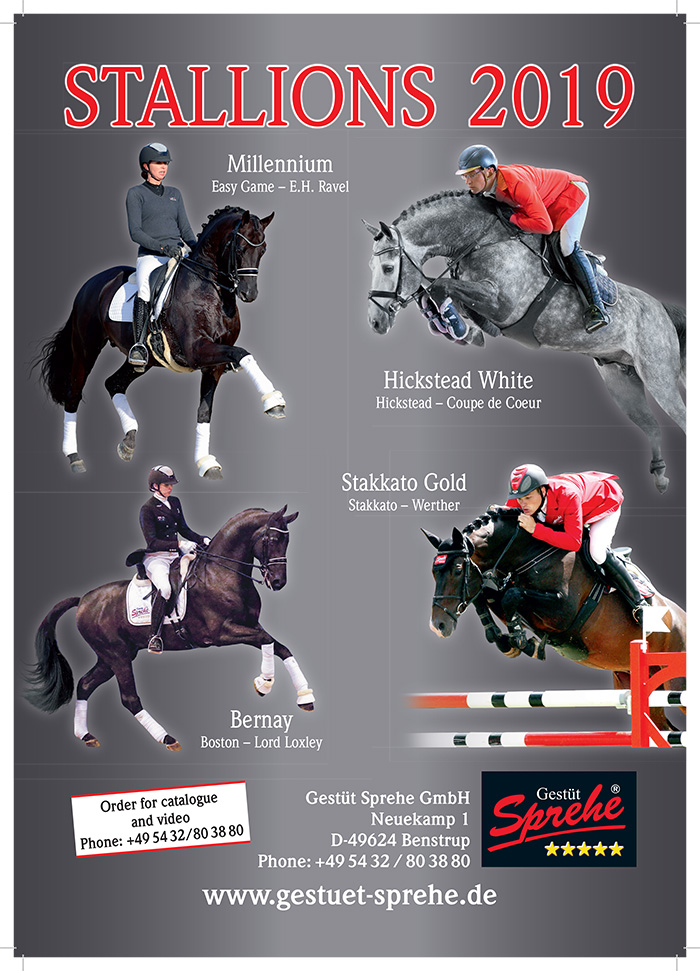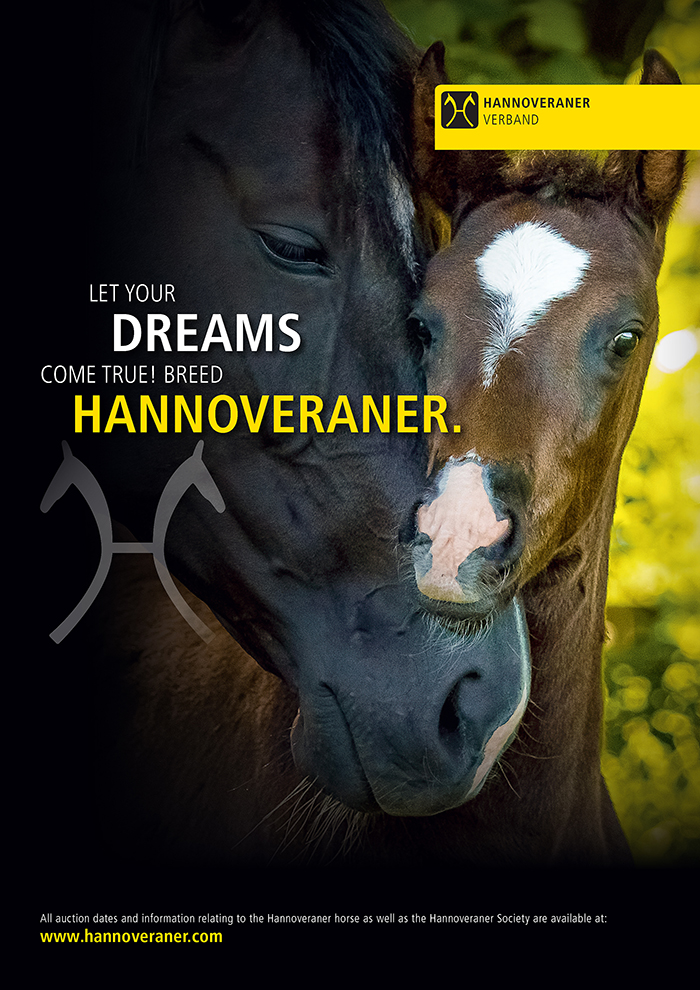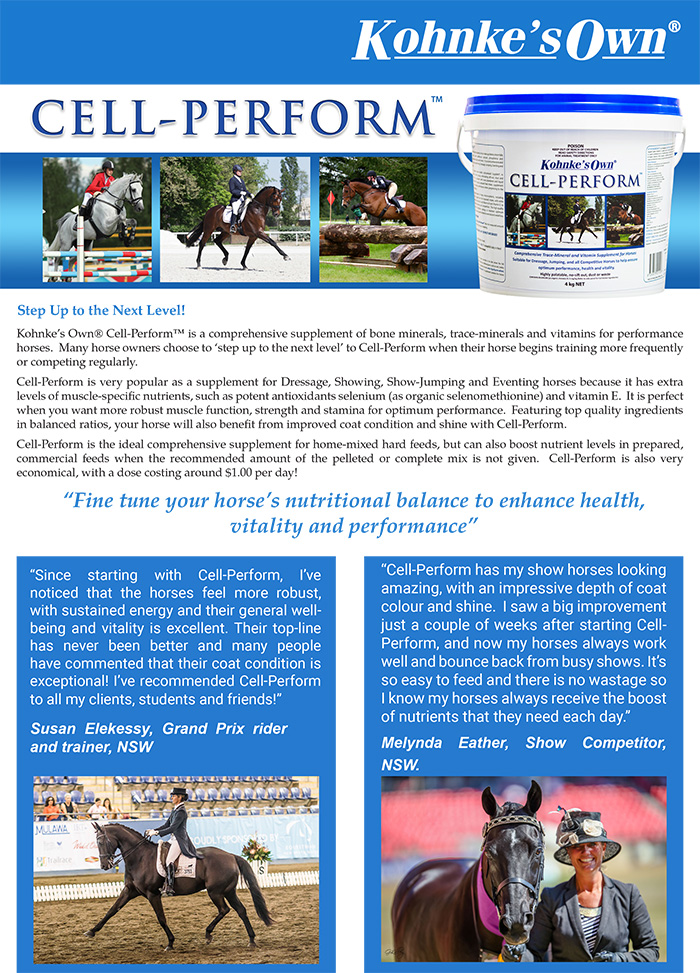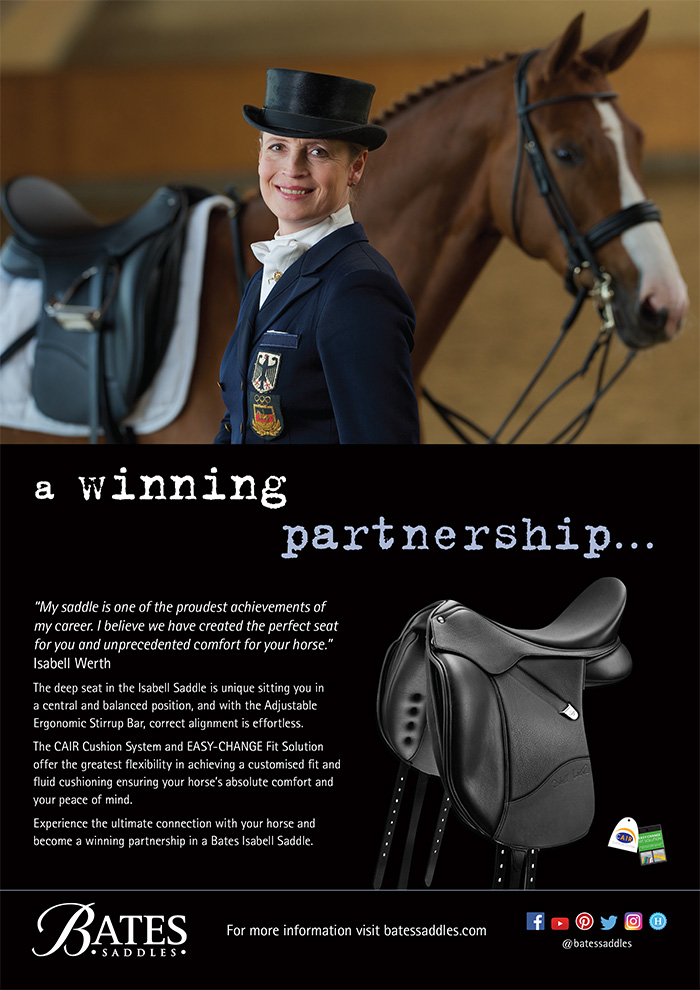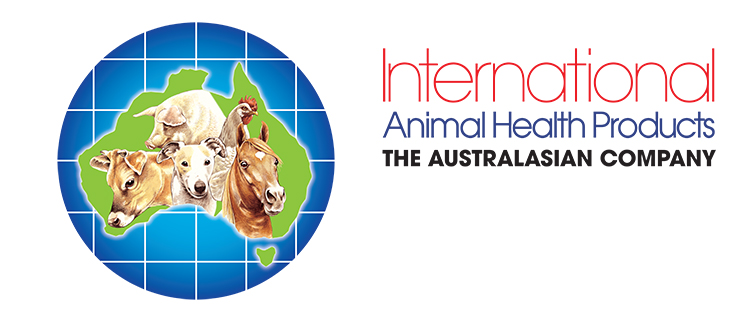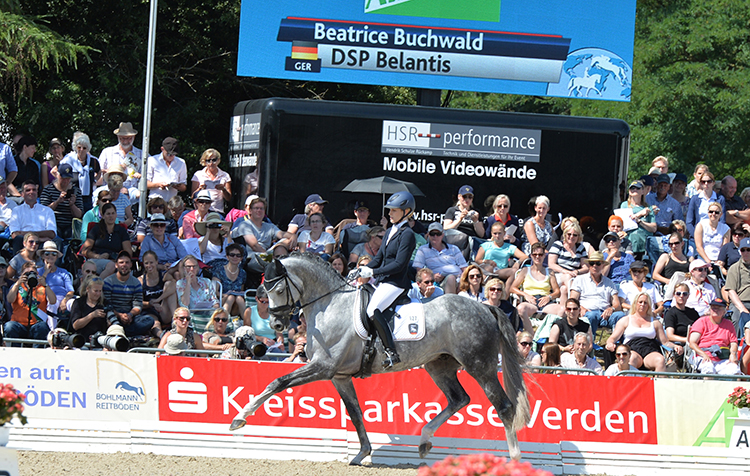
Rebecca Ashton interviews one of Germany’s (the world’s) most exciting new riders… Photos – Roz Neave / Rebecca Ashton / Kenneth Braddick
It’s would be easy to think that German dressage rider Beatrice Buchwald must be older than her 29 years. Not only has she had a career’s worth of successes from Young Horse to Grand Prix, but while based at Isabell Werth’s yard for five years, she was the main rider of Isabell’s latest star and current European Champion and Olympic silver medalist, Weihegold. Other superstars Beatrice has trained include Belantis, Victoria’s Secret and Daily Pleasure, who she still rides. Her successes have included three Bundeschampionate titles, a World Young Horse Championship title, she’s a Nürnberger Burg Pokal winner and a Louisdor Prize recipient.
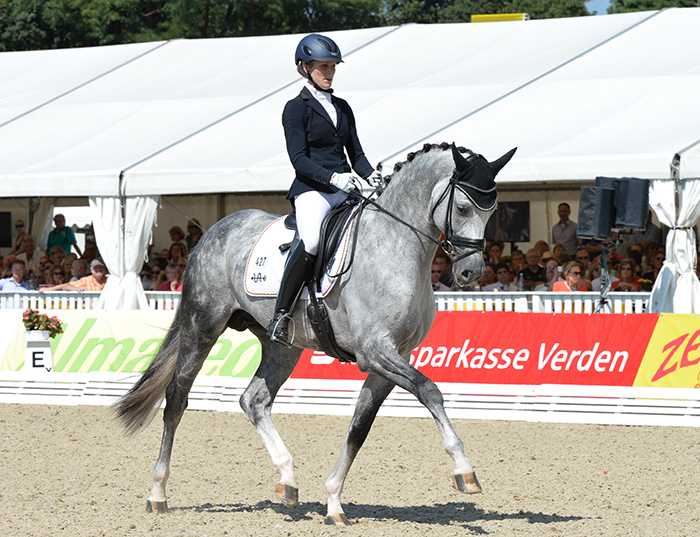
Belantis and Beatrice, Second in the Six-Year-Olds at the World Young Horse Championships in 2015. Belanitis is by Benetton Dream, from one of the ‘P’ line mares from Neustadt Dosse, Philharmonie: http://www.horsemagazine.com/thm/2017/11/jurgen-muller-reflects/
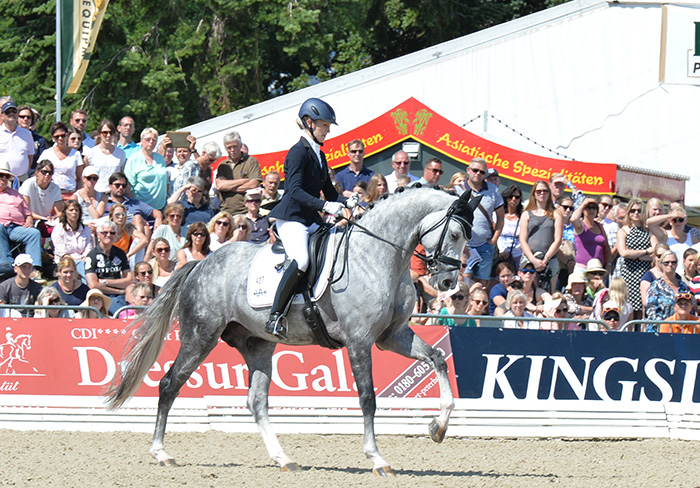 Beatrice left Isabell’s yard a year ago and has successfully started her own operation based at Gut Kostenschlag, the stable of long time friends and supporters, the Hödl Family. I caught up with her at the Bundechampionate last year, where she was busy competing three horses, including the Oldenberg stallion Fürst William HC (Fürst Wilhelm / Lord Sinclair I) taking out second place in the hotly contested Five-Year-Old Championship.
Beatrice left Isabell’s yard a year ago and has successfully started her own operation based at Gut Kostenschlag, the stable of long time friends and supporters, the Hödl Family. I caught up with her at the Bundechampionate last year, where she was busy competing three horses, including the Oldenberg stallion Fürst William HC (Fürst Wilhelm / Lord Sinclair I) taking out second place in the hotly contested Five-Year-Old Championship.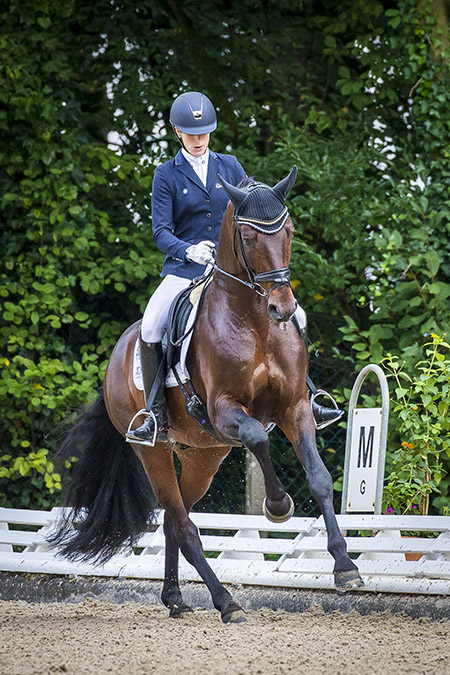 Beatrice and Fürst William, second in the strong Five-Year-Old Championship – Fürst William HC (Fürst Wilhelm / Lord Sinclair I)
Beatrice and Fürst William, second in the strong Five-Year-Old Championship – Fürst William HC (Fürst Wilhelm / Lord Sinclair I)
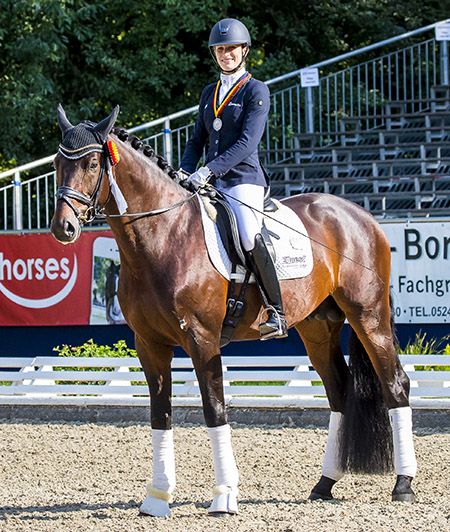
how Beatrice got into horses is next:
What was your introduction to horses?
My parents have a holiday house in the north of Germany and we would go for the holidays. I was five or six and I started to ride there because my parents didn’t have anything to do with horses. They are both music teachers, so normally I should play the viola or cello, which I did when I was a very small child but then I said, ‘Enough. Now horses.’
I started riding at home when I was seven. I always rode dressage. I had a teacher who was very old school. You had to sit on the horses really correctly and the horses came first. You had to ride very well and she was very strict, but it was a very good way to learn, really good basics. I was there for 10 years.
And then you left school. Was there any thought of doing anything other than horses?
I told my parents that first I would do the horses and then I would study, but really it was never my plan! I finished school at 19 with my Abitur. I stayed at school longer because if I was leaving home, I’d need my drivers licence so I thought it was better to wait!
You went to Jo Hinnemann’s?
Yeah that was my first big stable. I rode at really small shows before and I didn’t have the big, super horses because if your parents don’t have a horse business, ok we could buy a horse for €5000-€10,000, it is a lot of money, but not in the horse world. So until Hinnemann’s I had normal horses which were super to learn on but not for the Junior or Young Rider classes. When I decided to be a professional rider I had to leave the south of Germany where I’m from, because in the north it is a higher level of horses and I wanted to do it 100%, otherwise you don’t have the success. So for me it was difficult to go 500km from home, but it was the right decision I think.
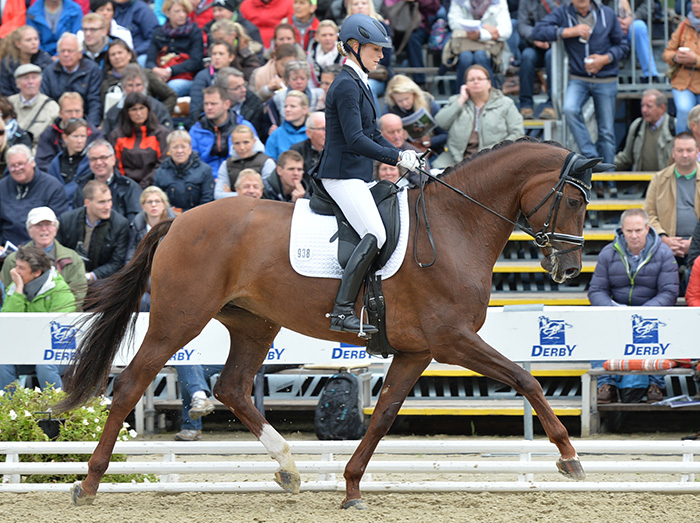
Another Bundeschamps star for Beatrice, Victoria’s Secret (Vitalis/Fidermark).
I was at Hinnemann’s for two years to do my bereiter and then another two years after that. I started with all the young horses there. That’s why I decided to stay a bit longer than the two years because the horses get older so I didn’t want to leave! I did my first Bundeschampionate there with Lord Carnaby as a three-year-old. It all started with that horse; I won the first Bundeschampionate, the first World Championships, the first stallion show. It was the beginning of everything. This is the horse of the Hödl family so we’ve been together a long time and we’re good friends. And it was also nice because I’ve learnt together with the horses. I have never had a finished horse. It needs more time but in the end, I think it’s better.
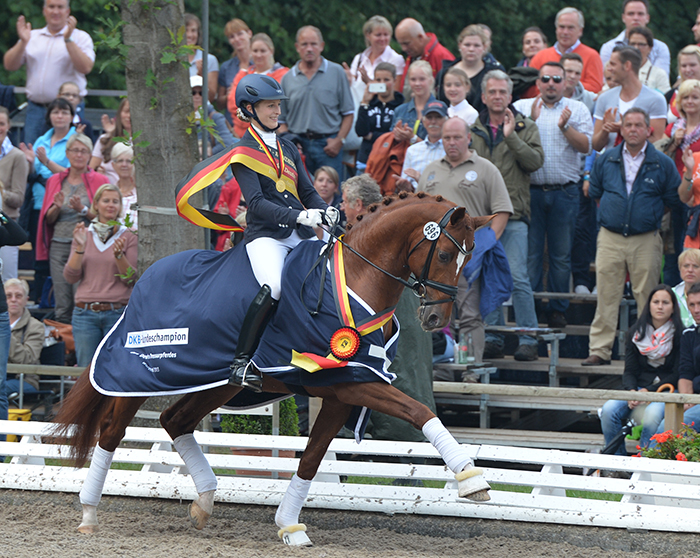
Lord Carnaby
What was the biggest impression you took away from Hinnemann’s yard?
It’s difficult to say. He’s a really good teacher. I think the really big thing was that I learnt to work alone with the horses. He was not sitting there all the time saying do this and do that, even though he had his eye on us.
next Rebecca asks about the move to Isabell’s stable
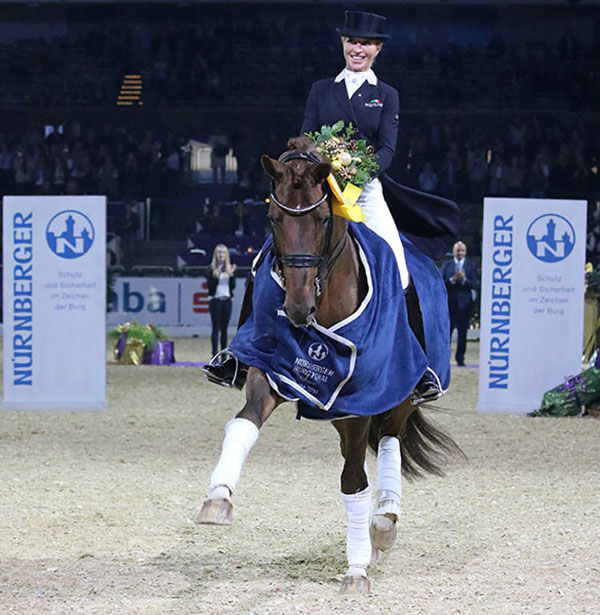
Want to Breed to Vitalis, go to www.ihb.com.au and find out how
Then you went to Isabell Werth’s stable. How did that opportunity arise?
After four years it’s long enough, you want to see something else. Isabell was always the big idol and she wasn’t that far away from Hinnemann’s stables, about half an hour. The Hödls said we could do something together. They had one stallion at this time so we started a co-operation with Hengst Station Schult. I was still living next to Hinnemann’s place, and it was 50 minutes one way to the Stallion Station, and Isabell was 30 minutes the other way.
So, for the first year, I spent half a day at Isabell’s and half a day at the stallion station. I had about four or five horses belonging to the Hödls and another three or four horses, then the stallion at the Schults’ Station, so I rode around 10-12 horses a day. You have to wake up early!
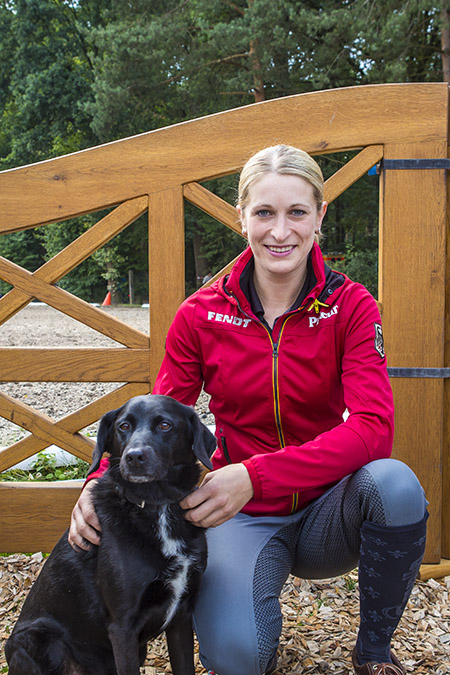
What was the biggest thing you learnt at Isabell’s stable?
I think she is an amazing person, an amazing rider and amazing trainer. It was really interesting just to be in the arena and seeing how she’s working and riding the horses. Her lessons are really special because she’s not like Hinnemann who was more the Training Scale, more theoretic. Isabell is more, ‘…at this moment you have to use right leg, right hand…’ and you do it and then….oh, it works! She’s riding with you and she tells you what she would do at that moment and then it is working. She likes really different horses. It’s not just one type of horse that she does and she never says, “Oh this is a shit horse,” she’s looking and trying and seeing what she can do or what is best for that particular horse. That’s the most important thing. And it was very interesting to learn the management of such a stable and how to work before a show and then show, show, show and then the big show. You have to plan the year and plan the horse. You don’t go to 12 shows and then the 13th show is the most important, and the horse is tired.
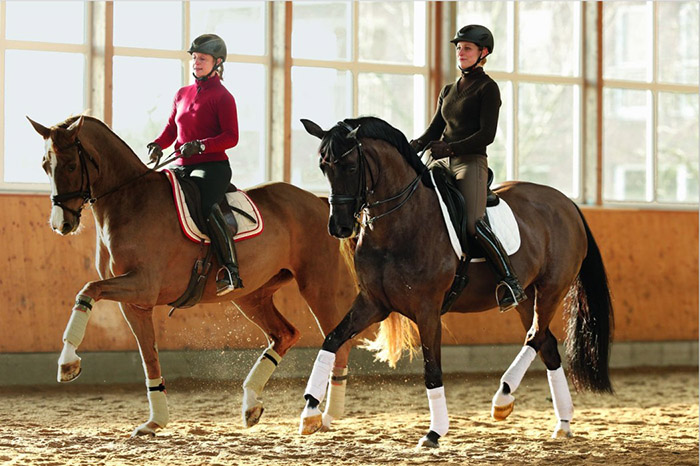
Isabell and Bella Rose, Beatrice and Weihegold – photo – Jacques Toffi
Does she buy her horses young?
Normally yes, but then you don’t see them for the next five years because they are at home. Sometimes you feel, ok it is a nice and clever horse and it will do everything, but it can’t come to the big Young Horse shows because it doesn’t have a big trot and big canter.
What do you think makes Isabell such an incredible competitor?
I think she’s amazing in the head. If she’s riding, the house could fall down; she’s riding. I think nobody can manage bad situations like her. If you are on the top everybody wants to bring you down, and she’s been fighting for so many years, it doesn’t matter to her. If she has no success for one or two years, she’s working, working, working and then she has her next horse and then she’s at the top again.
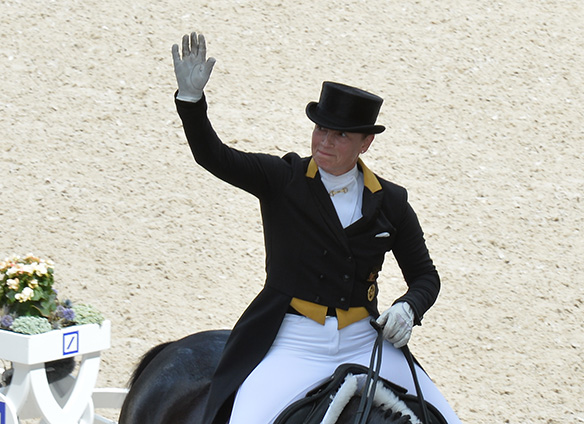
Isabell at Aachen, waving to the crowd, but keeping an eye on the scoreboard until she sees the result…
What have you learnt about the art of competing from Isabell?
She was always a really big help as a trainer because she never pushed too much. If you come out (of the arena) and it was not so good, she would say, ‘Oh, it was not so bad!’ She’s always positive. If it was ok, she’d say, ’It was not perfect for today, but it was perfect for you and the horse.’ You have to see what’s possible and what’s not. She’s realistic.
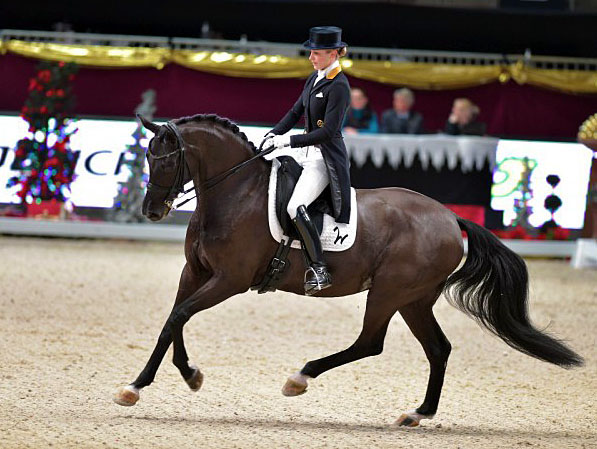
Beatrice and Weihegold in the Grand Prix Special at Salzburg,
they won with a score of 72.667 – photo: Kenneth Braddick
You trained Weihegold up to Grand Prix and then the ride went to Isabell. How do you feel now watching her in the medals at Rio and the Europeans?
I’m so proud.
When did you start riding her?
When she was six I started with her.
What was she like as a youngster?
She was always special. She never had the big movement. Nobody would watch her and think, ‘Wow, she’s amazing!’ but if you sat on her…. I never rode piaffe or passage before I rode her and I was trotting at six years old and just came with the whip….. normally you can’t ride her with the whip, she’s just really hot.. but I just touched her and thought, ‘Wow! What’s this?!’ I felt it was special, but I didn’t want to say too much because I wasn’t experienced enough to comment.
Then she learnt in three months the changes. I got her at the end of six years, and in April she was seven and won her first M level and in June she won her first S level, in October her first Prix St Georges. She’s so clever. At eight she won the Nürnberger Burg Pokal. It was amazing to qualify a horse and amazing to ride in Frankfurt, but we didn’t think that she would win because she’s not the most spectacular horse, but she has no problems in a special atmosphere and she comes in and is with you 150%.
And then she was your first Grand Prix horse?!
At which point we both start giggling like schoolgirls at the crazy prospect of having Weihegold as your first Grand Prix horse and the champion she’s turned out to be…
And what’s she like in the stable?
She’s really normal. The only thing is her food. She is a bit fat and likes food and if she wants to eat she bangs and bangs. But that’s the only thing. You can sit a child on her and go for a walk. I would go alone in the fields with her, she’s never crazy in the prize-givings. She’s hot, but never crazy. But she’s sensitive. You must never fight with her.
**There’s a YouTube video of Beatrice riding Weihegold at the end of this article
next the difference between riding young horses and Grand Prix horses
Do you prefer the young horses or Grand Prix?
I like it all! It’s much easier to get the young horses because there are more of them.
But then they can be a bit crazier….
Ja but I like that. I don’t want them to kill me, but they can be fresh, it’s no problem for me. I like to work with the stallions also and now I have around 15 horses from three years old to 16 years old and I have one rider, a groom and the Hödl Family to help me.
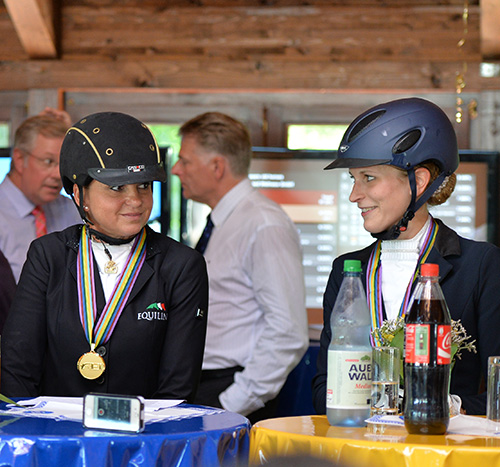
Dorothee Schneider, who rode the Six-Year-Old Champion, Sezuan, and Beatrice, Runner-Up with Belantis at the WYH Press Conference in 2015
What’s your favourite type of horse?
They have to be sensitive and intelligent and if you have three good gaits, then it’s perfect. But you never have everything, so you have to see how you can manage a problem, but the most important thing is that they have to want to fight for you. They can be spooky at home, but if you’re in the arena, they have to fight for you.
When you get on your horse everyday, what are you feeling for?
Normally the horse is walked in hand first by the groom for about 15 minutes to get it a little bit warm and then I get on and start with the walking work but it’s different. With the three or four-year-old horses I don’t like to ride too much walk on the rein; long rein then start with the trot and canter because normally the walk is a bit difficult in the beginning. With the older horses I do more walk in the beginning then warming up for 10-15 minutes and around 15-20 minutes of working with breaks.
How do you usually structure your training?
I think the most important thing, if you work together with Isabell, she teaches that the most important thing is to have them soft, going through the back soft. That part of the exercise is 10% of the daily work. Getting them more gymnastic.
With the management of the horse, we always start one week before the show to get more of the exercises from the test. But in the daily training, ok sometimes I say today more canter work, tomorrow more trot because if you train a Grand Prix horse, you can’t train everything in one day.
So, if one day my horse needs more canter, I warm them up with of leg yield or shoulder in or half passes and then into the canter work. And you have to stop before they are too tired.
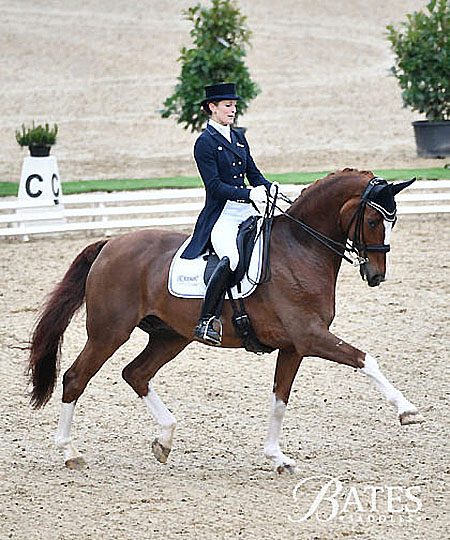
Beatrice and her current Grand Prix ride, Daily Pleasure. Like Isabell, Beatrice is a Bates Advocate, and proudly rides in a Bates saddle.
Do you take them in the field?
Yes. Not all horses because not all the owners want it, but I ask the owners and if they are happy, we have smaller paddocks, bigger paddocks, fields.
Do you ride them out as well? You’re probably way too busy!
If we have time we go out. Sometimes for relaxing days we do it. Not with the three-year-olds! But we have a big outside arena and they go to the fields as well.
You’ve got your own horses now?
I’ve got one young horse who’s three years old. I’ve never had my own horse, but now I have the opportunity to have a horse in my stable because in the last years if you are riding 12 super horses and then in the evening you have to drive to another stable to ride the 13th horse, and usually not the nicest because you can’t afford the super horse yourself! But I found a really nice two-year-old last year so now we can try.
At home he is called Heinz but he has another name for the show! He’s by Follow Me and I really like him, but he’s at home in the field.
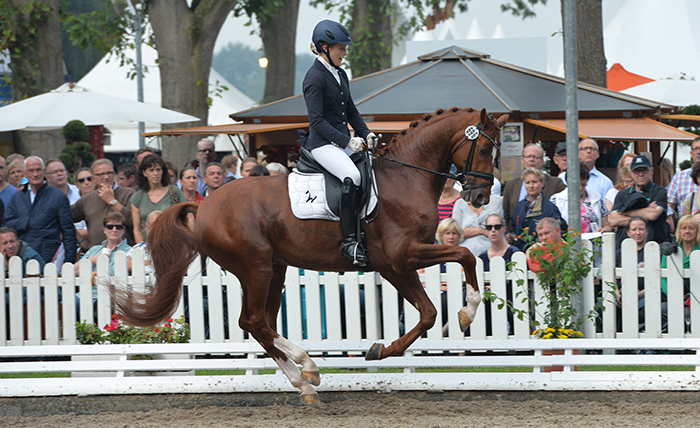
Lord Carnaby decides to show the crowd a big change at the Bundeschampionat
What’s your biggest tip for people competing a young horse in a big environment, for example, the best way to handle the warm up arena at a big show?
I think the biggest fault is if riders want to do it better than in the normal shows. Then the young horses get upset. Don’t change anything. Be focused on that.
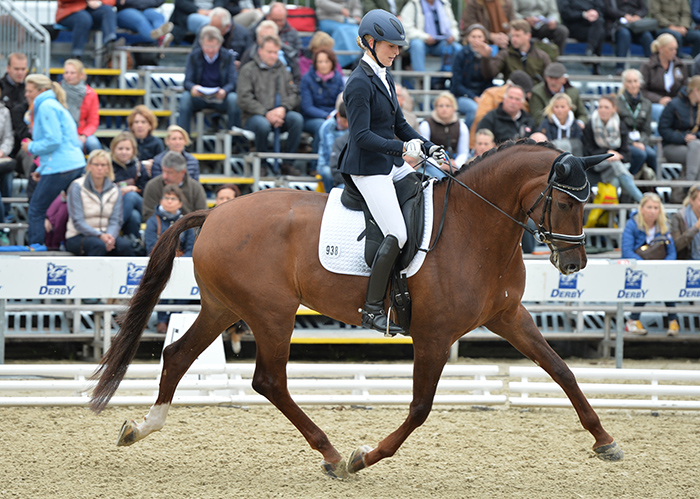
Victoria’s Secret coping with the atmosphere in the 3 and 4 year old class
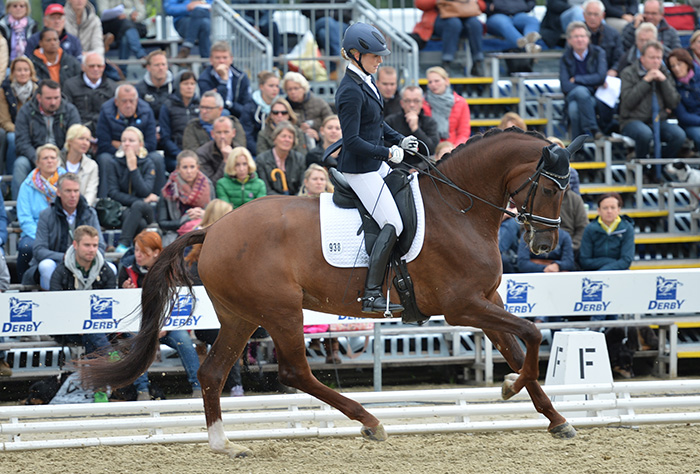
How do you manage, say a three-year-old horse in this situation (we were at the Bundeschampionate). It’s very stressful. Do you think a three-year-old is too young for these shows?
Normally yes. I have one really good three-year-old, Daria but she is at home because of this point. She won in Verden. She’s sensitive and is a super horse for the future. With stallions they start at two-and-a-half years old with the licensing so they see a lot more, but normally at three-years-old they are on the field and with my own horses and the Hödls’ horses, we start riding them at three-and-a-half just one or two times a week, and after the winter, they can do a bit more, and then it’s ok to start them here as a four-year-old. If you want to go to the Bundeschampionate you have to push them a bit more, you have to ride them more and a lot of them get problems. Ok, so if you have a really good horse, perhaps it’s ok.
What’s the quality like at the Bundeschampionate this year compared to other years? Or is that not fair to ask seeing you’re competing!
The problem is I don’t really have the time to see so many horses. It’s easier to ride and not look at the others and then if they beat you, you can say, ok they must have been better. But if I see them and I know it was not better, I get angry! Normally I don’t look before the show who is judging or what the marks of others are before I ride.
There’s never been so many horses in the five-year-old class! (There were 75 starters). It’s difficult because it’s easier to qualify in the south or east of Germany than here. Sometimes you qualify a horse up north here with 8.0 and sometimes down south you can qualify a really normal horse with 8.5. But I saw it with the World Champion qualification here at Warendorf, there were over 40 five-years-olds and normally not more than 20 are coming here to present for the selection for the World Championship, and they were really, really good horses. Normally there are five top horses and 20 you think could have stayed at home.
next, we discuss keeping young horses sound
A lot of the young horses you don’t see again, but you’ve managed to train some top young horses all the way through the grades. How do you manage the horse to keep them sound?
The big thing is not to do too much. You have a first impression; if it is a softer horse or a stronger horse. Things can always happen, they can hurt themselves in the paddock. You need not think everyday that you have to be careful, just be sensible. Always, some people want to come here with their three or four-year-old because they want to sell them so for them it doesn’t matter, but if you want a future horse, for example Isabell’s horses never go here normally. You don’t need to come here to have a Grand Prix horse later.
Are they two different types of horses?
Yes I think. There are some special horses that can do both, but they are like one in a thousand.
For big shows, do you have any coping routines or treat it like another show?
I try to treat it like a normal show.
Do you ever get nervous?
Not too much. Sometimes when I go to the first Grand Prix… if you know you have a really good horse and you want to win… With the young ones it’s more difficult because you never know how they handle the atmosphere.
Belantis in Verden in the final, I was really nervous because in the six-year-old class, you never know if the changes are good, but you know you have a horse that can win, so you think, will it work?! Then I am a bit nervous, but normally no.
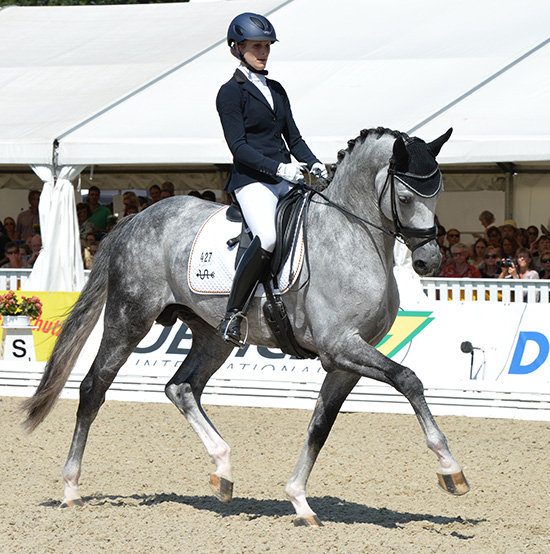
What was Belantis like to ride?
He was perfect. He’s really sensitive and he’s hot but it’s like sitting in a chair; really comfortable and really soft in the mouth and it’s not all stallions that want to come into the arena and you know that they’ll give you 100%. At a show, he has that presence that he is the best.
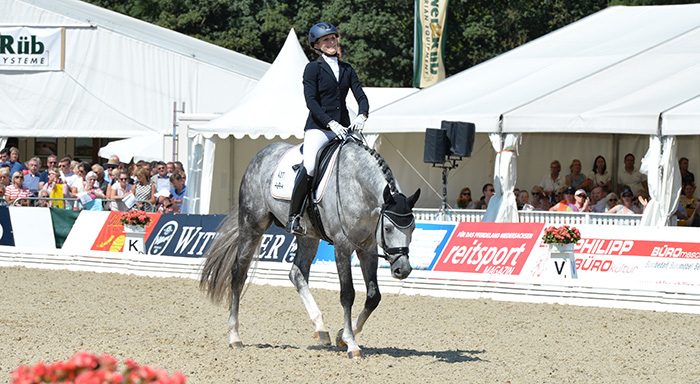
Is Isabell working him now?
Yes.
Was that hard, handing over the rides on those top horses?
Ja, a bit, of course but I knew it before. So, it was clear that I would ride him for the young horses and so it was not a surprise. For me, if you know a horse is coming and it’s for sale, ok you know. Or if a horse stays for a longer time, you have to be professional, it’s your job. Ok it was the first really good horse so it was more difficult than now, but you know new horses are coming, and you just have to do it. If you can’t let them go, you would never get them in the first place. There are really special horses and I’ve had a lot of special horses in my short career, so I’m really happy to have been a part of their success.
I noticed this weekend Hans Heinrich (Meyer zu Strohen) was helping you.
At home sometimes Isabell is coming or I go to her, and Sebastian Heinze is coming for the young horses when Isabell is busy. She was at the Europeans so I asked Hans Heinrich to help me here because he’s really top with the young horses.
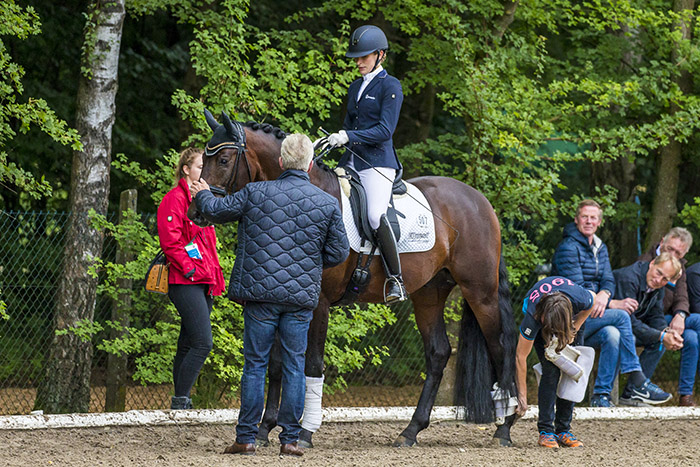
When he’s warming you up, how is it different to Isabell?
The interesting thing is with him the first step you are walking… a bit more left leg and right rein… so it’s also good for me to realise the small things because usually you do it but you don’t think about it. He’s really with you, so then when you’re riding in the competition arena, you can hear him.
Do you ever teach?
I try not to. I do it once during the week for a neighbour, but it’s just because they are friends. There are so many people asking, but I’m just too busy. After 10-12 hours riding, you don’t want to sit for three hours in the corner in the evening, and at the moment I think I am young and healthy and I can ride, so I can teach later.
For riders on their own, what’s your top tip?
I think the most important thing is to be realistic. What can I do on the horse? How good is my horse? And where are our problems? Then you can start to work on them. You have to know and then you have to feel the problem and then you have to think about it and get a teacher to help you through it.
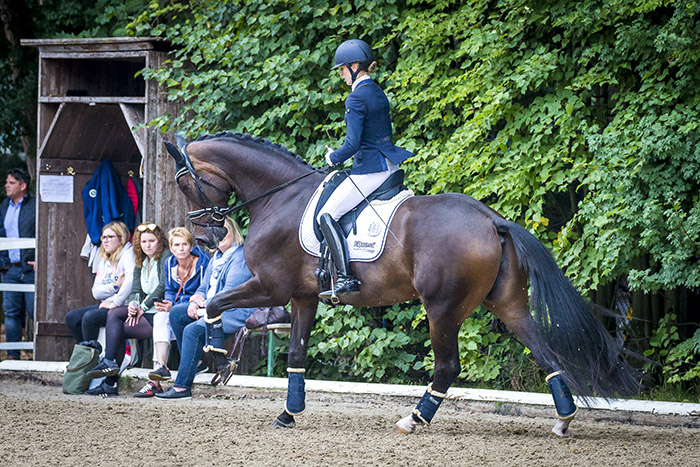
Another ride for Beatrice at the Bundeschamps – Filia M (Fürstenball/Ferragamo)
How has it been for you, moving out of a big stable to being on your own. Which way is easier?
The first week I thought, ok, now I am alone, but at Isabell’s stable she is every week not at home, and at Hinnemann’s stable it was the same, so we learn from the beginning to work alone and to think about ideas to handle the problems and then Isabell comes and sees, and it’s either, oh, it’s better or not, we have to do it like this. You have to try and then you feel it’s better or it’s not.
But you’d also be riding with other people at Isabell’s but now you are really on your own…
Ah yes, but I have my rider at home, and I have Marlene Hödl and she sees a lot from the ground and she knows me, and she knows the horses.
So, it was a big thing to go alone, but you have to do it once in your life. For me, I want to learn from the best, but I also wanted to have my own business one day so I think it’s easier to start when you’re not too old. If I start when I’m 40 I think it’s harder.
Have you had one standout challenging horse?
At the start all the horses were like that!! haha. No no. I took five horses when I went out on my own, but all the other professionals were laughing because ok, if there is someone starting their own business, everybody with a problem horse will bring it to you to try!
Did you get that?
Ja a bit! I got also some young horses for working, but the older horses you get when you are new have sometimes some problems, so it was really interesting!
more follows
Do you have any Grand prix horses coming up?
I have Daily Pleasure. I have one young Diamond Hit horse, Den Haag who is a nine-year-old stallion. I think he’s talented for piaffe/ passage, but it’s a long way and they need to stay healthy.
Do you get to go home and see the family much?
No. I have no time. My Mum is always coming to the shows so she can see me! My last holiday was eight years ago.
Beatrice’s mother will no doubt have to keep up her show visits for quite some time to catch up with her charming and talented daughter and it would be no surprise if one of those show visits is an Olympic Games or a WEG. We’ve only just seen the start of a brilliant career. Beatrice exemplifies what is best about the German system and the depth of the country’s talent.
Beatrice riding Weihegold at Grand Prix level before Isabell took over the ride



